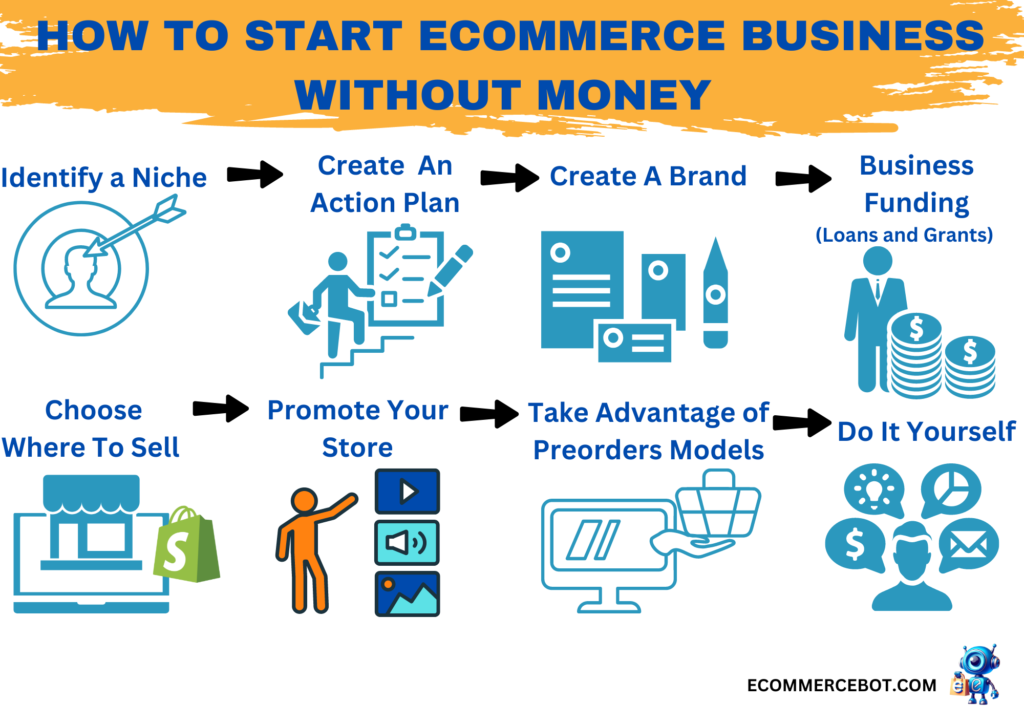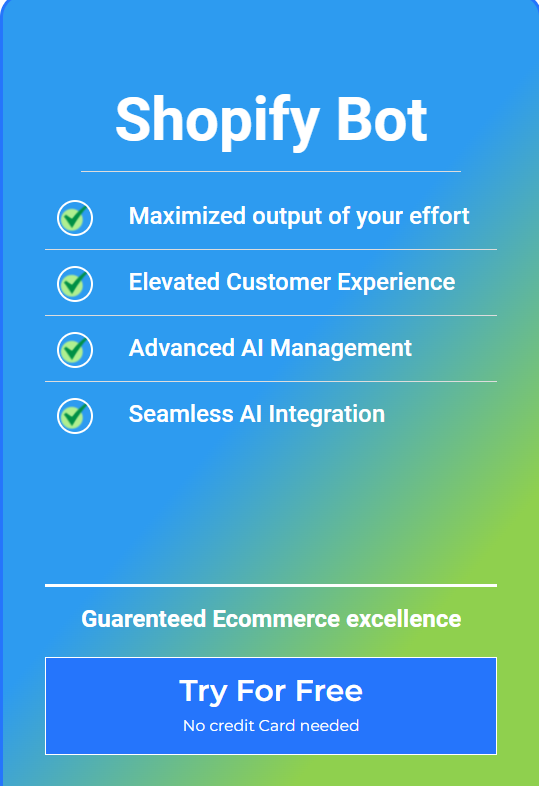We are at the digital stage, where everything, including businesses, is moving online. Billions of people shop online, and connecting through social media has become more accessible.
Statistics show that e-commerce sales are expected to hit $6.9 trillion in 2024. Existing entrepreneurs are moving their businesses online, while beginners are looking for ways to start an e-commerce business without money.
If you have a good business idea but need more startup capital, don’t fret.
There are plenty of ways to start an e-commerce business with little or no funds and work up to success.
How is this possible?
Without wasting time, let’s dive into more details of how to kick-start a successful e-commerce venture with a little dime.
Table of Contents
Understanding e-commerce business
Many people start the e-commerce business incorrectly and call themselves entrepreneurs before failing terribly. It’s essential, especially for beginners, to understand what e-commerce entails.
E-commerce, the short form for electronic commerce, is a term used to describe online businesses.
Trade for goods and services carried out on the internet falls under e-commerce and can be classified as B2B (business to business), B2C (business to consumer), or C2C (consumer to consumer).

Unless you allow laziness to stop your progress, the e-commerce market has plenty of opportunities for upcoming entrepreneurs to explore.
Considering the projected growth, there is no better time to start a business online than now. Don’t worry about the initial capital; start small by selling products on B2C platforms like Shopify.
Building a substantial business is easy if you do the work, research, and creativity.
Starting an e-commerce business on low funds
The first step in starting an e-commerce business is to develop a business idea. This is the first half of the battle, whether you have the capital or not. The other half is funding your concept, which many people need help with. You can start an e-commerce business without money and stick to the goal of making money to reinvest later on. This is how to do it.
1. Identify a niche
Looking for a business idea falls under this step – selecting a niche. You need to specify a market segment dealing with a particular product(s).
The niche should be narrow enough. Instead, aim for a healthy balance that resonates with your target customers.
Remember, businesses online thrive on creativity. Look for a niche where you can maximize your creativity and sell unique products to your target audience.

One low-investment startup idea is drop shipping. Once you have identified the niche, try to drop shipping, which requires minimum or no capital. You don’t need to stock up to sell; vendors charge you for the items you sell and drop them directly to your customers.
A platform like Shopify makes it easy to drop ship. The Shopify bot helps you provide exceptional customer support on all social media channels and track orders in real time.

Begin by sourcing and marketing the trending items organically or through Search engine optimization(SEO).
Another way to start ecommerce business without money is to sell your services. Identify the things you do better and package the skills into a service business.
Examples of these businesses include virtual assistance, bookkeeping, handyman services, social media marketing, etc.
Print-on-demand is another low-cost business that you can start with no cash. Create your brand and designs and sell items on a per-order basis.
Print-on-demand costs are minimal, no storage expenses, and you can change the products at your convenience.
2. Create an Action Plan
If you have an idea, the next step is to create a plan for conducting your business. A business plan is the master plan for any successful business and should outline your business goals. It’s essential to break the goals into smaller milestones to achieve them.
In the action plan, determine your main products, your target audience, and the channels you’ll use to reach out to them. It’s crucial to identify the e-commerce business models to use. Is it dropshipping? Or is it in-house fulfillment?
Depending on your business, choose the model that makes the most sense.
A business plan should include the following:
- A description of your company
- The selected business model
- Products or services offered
- Market research and marketing strategy
- Operations and logistics plan
- Key milestones
- The team
- Financial plan
3. Create a Brand
The first step in building an e-commerce brand is choosing a name. Since e-commerce requires creativity, the business’s name should be catchy and unique.
You’ll use the name for as long as the company is running, so it should be a name that won’t interfere with the business’s scalability in the future.
Match your e-commerce business name with your online assets, such as the website domain name, social media handles, etc.
Building a brand continues; a good brand sets your business apart from your competition. It would help if you determined the brand story, values, aesthetics, style, voice and tone, and hiring practices. A strong brand guides your communication style and social media marketing efforts.
You want to be included and own a business with a visitor destination, so you need a website for your store.
A website is a hub for your products or services. If you’ve saved some cash, build a website with professional features to enlighten potential customers about your brand and what you offer.
You don’t have to beat yourself up if you are on a tight budget.
You can still run your business effectively without a website through social media channels and launch it later.
Sign on Shopify and ejoy $1 per month trial.
4. Business Funding
You don’t need money to start a business online but a plan to fund the possible costs. If you want to start on a high note, consider applying for loans, grants or finding potential investors.
Access loans from financial institutions that offer credit facilities near you. Loans are paid back with interest, and you need to figure out how to maximize your business returns to service them.
Conversely, grants are one-off lump sums of money given mainly by the government to small business owners. The advantage of grants is that you don’t need to pay them back.
Finding investors can be demanding, but it can provide a reasonable amount of money for the business. Most investors provide capital in exchange for an equity stake.
If you want to start the business at zero, identify which costs to avoid and the impact they could have on your business. However, starting an e-commerce business at $0 is hard work.
Therefore, having little cash with you is essential to bypass the hurdles. Once you validate your business and generate income, you can reinvest the profits.
Cash flow issues are likely to interfere with a business’s growth. This is why many e-commerce entrepreneurs look for a certain amount for startups to purchase and market items effectively.
5. Choose where to sell
When starting an online store with no money, you must learn where to find the proper sales channels. The e-commerce platform you choose will determine whether your business thrives or fails.
Consider whether the platform has features to help your business run smoothly.
Depending on your chosen platform, you can build a visually appealing online store without hiring a designer.
Platforms like Shopify have drag-and-drop features and pre-made templates to help you organize your online shop.
You can seamlessly personalize your store, control customer data, and easily target customers. List the products you want to sell in your store, save them, and then publish them to add to the store.
6. Promote your online store
A new business requires an all-encompassing marketing strategy to succeed. You can increase sales and expand your customer base by trying various marketing channels. One of the most effective marketing strategies today is social media marketing.
For social media advertising, use the e-commerce bot, which helps you create and run ads on social media platforms.
The E-commerce bot also offers live chat assistance to help keep your customers attended to via the live chat feature.
Ensure you post eye-catching photos and occasionally give offers and contests to attract more customers to your store. Keep publishing relevant content. Customers trust your brand if the posted content aligns with it.
7. Take advantage of the Pre-order Models
You want to start an e-commerce business, but you are penniless. And now you think that life is going to come to an end soon and you are going to die poor?
Here’s the good news! You can validate your business ideas with pre-orders.
So, how does it go?
You’ll take pre-orders from customers, collect cash in advance, and then sign off on production. Customers are willing to pay for the products before they are available, especially for limited-edition items. This model sounds like a plan. This model will help improve your cash flow, customer loyalty, and demand forecasting. It’s also an excellent hype strategy that creates awareness about your new brand.
8. Do it Yourself
In the beginning, you have to take complete control of your business. There will come a time when you’ll be forced to delegate some duties. Be there for your business as it takes its baby steps.
Learn as much as possible about running an e-commerce business at low or no cost. Learning will sharpen your skills and help you manage the business better as it grows.
Embrace the entrepreneur community, and don’t be afraid to incur some costs.
This may save you in the long run. These communities give you access to knowledge and support that will help you avoid costly mistakes in the future.
You are in the e-commerce business to build your dream. Control your costs, and your business will flourish at lower costs than you expect. You’ll master doing more with less and watch your business grow profitably.
Start Ecommerce Business Without Money: Wrap it up!
If there’s anything to take home in this guide, you can start an e-commerce business with no Money. The business world holds many entrepreneurs who have started their online businesses from scratch with less or no money.
Make the e-commerce bot your all-time partner for the smooth running of your business. Please take advantage of our one-month free trial and witness how the power of AI can create, optimize, and market your business through the social media AI manager.
This tool will help you make product posts and videos, respond to customer queries, build and run ads, write captions, and save time and energy.
Frequently Asked Questions (FAQs)
- Can I start an e-commerce store with no money?
Yes. You don’t need startup capital to start an e-commerce store. With just a few dollars, you can choose a niche, market your products, and sell them without holding inventory.
- What are examples of e-commerce businesses?
There are various examples of e-commerce businesses, including B2B (business to business), B2C (business to consumers), and C2C (consumer to consumer). Shopify, Etsy, Ebat, OLX, and Amazon are examples of e-commerce businesses.
- How do I start an e-commerce business?
Start by identifying the products you can sell. Research and find ways to set yourself apart from your competition. Create a business plan and then build your brand. Ensure you give it a name and logo that resonates with the target customers. Set your goals and put your marketing strategies in place. If you have the muscle, you can build a website or do this later as your business grows. Launch your company, and you will be good to go!

